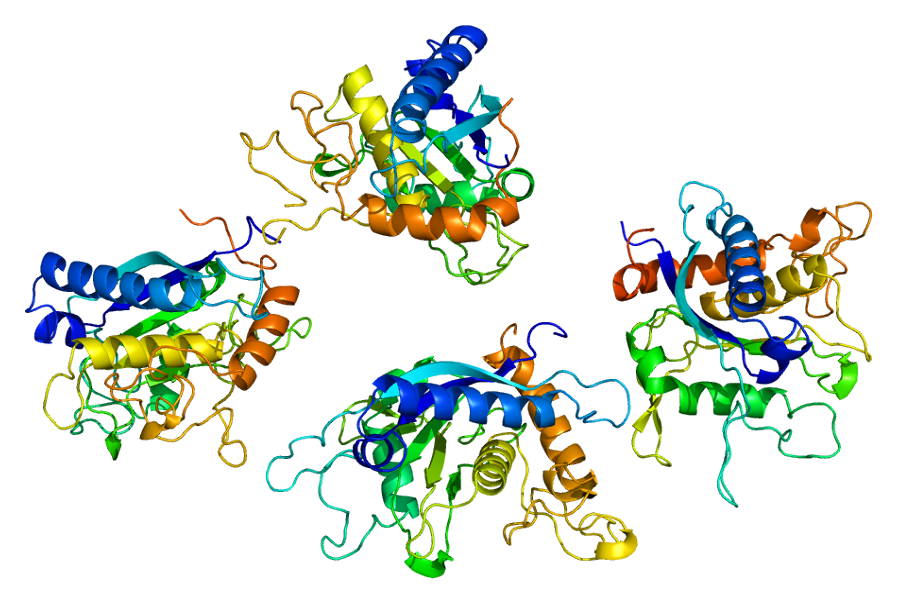DEFINITION
ADAM17, also called TACE (tumor necrosis factor-α-converting enzyme), is a 70-kDa enzyme that belongs to the family of disintegrins and metalloproteases.
THE GENE
CHEMICAL STRUCTURE AND IMAGES

Protein Aminoacids Percentage (Width 700 px)

SYNTHESIS AND TURNOVER
ADAM17 is expressed at highest levels in Heart, Platelet, Skin, Liver and Kidney.

CELLULAR FUNCTIONS
ADAM17 was the first 'sheddase' (enzymes that cleave extracellular portions of transmembrane proteins, releasing the soluble ectodomains from the cell surface) to be identified. and is also understood to play a role in the release of a diverse variety of membrane-anchored cytokines, cell adhesion molecules, receptors, ligands, and enzymes.

ADAM17 is understood to be involved in the processing of tumor necrosis factor alpha (TNF-α) at the surface of the cell, and from within the intracellular membranes of the trans-Golgi network. At the cell surface, pro-TNF-α is biologically active, and is able to induce immune responses via juxtacrine intercellular signaling. Pro-TNF-α can undergo a proteolytic cleavage by ADAM17 at its Ala76-Val77 amide bond, which releases a soluble 17kDa extracellular domain (ectodomain) from the pro-TNF-α molecule. This soluble ectodomain is the cytokine commonly known as TNF-α, which is of pivotal importance in paracrine signaling.

ADAM17 is also responsible for the proteolytical release of soluble JAM3 from endothelial cells surface. and other cell-surface proteins, including p75, interleukin 1 receptor type II, transforming growth factor-alpha, L-selectin, growth hormone receptor and MUC1. It is also involved in the activation of Notch pathway (By similarity).
REGULATION
ADAM17 has a multidomain structure: other than a prodomain, it has a catalytic domain, a disintegrin domain, a transmembrane domain, and a cytoplasmic domain.
It can rapidly responds to the physiological signaling pathways stimulated by Thrombin, EGF, LPA, and TNFα. Stimulation of ADAM17 is swift and quickly reversible, and does not depend on removal of its inhibitory pro-domain by pro-protein convertases or on dissociation of an endogenous inhibitor, TIMP3. Moreover, activation of ADAM17 by physiological stimuli requires its transmembrane domain, but not its cytoplasmic domain, ruling out inside-out signaling via cytoplasmic phosphorylation as the underlying mechanism.
DIAGNOSTIC USE
Defects in ADAM17 are a cause of neonatal inflammatory skin and bowel disease (NISBD). NISBD is a disorder characterized by inflammatory features with neonatal onset, involving the skin, hair, and gut. The skin lesions involve perioral and perianal erythema, psoriasiform erythroderma, with flares of erythema, scaling, and widespread pustules. Gastrointestinal symptoms include malabsorptive diarrhea that is exacerbated by intercurrent gastrointestinal infections. The hair is short or broken, and the eyelashes and eyebrows are wiry and disorganized.
References
Blaydon DC, Biancheri P, Di WL, Plagnol V, Cabral RM, Brooke MA, van Heel DA, Ruschendorf F, Toynbee M, Walne A, O'Toole EA, Martin JE, Lindley K, Vulliamy T, Abrams DJ, MacDonald TT, Harper JI, Kelsell DP.
Inflammatory skin and bowel disease linked to ADAM17 deletion.
N Engl J Med. 2011 Oct 20;365(16):1502-8. doi: 10.1056/NEJMoa1100721